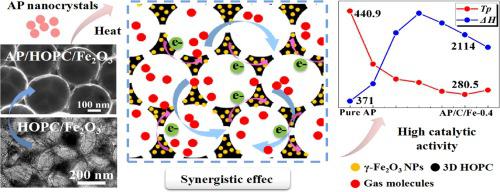当前位置:
X-MOL 学术
›
Appl. Surf. Sci.
›
论文详情
Our official English website, www.x-mol.net, welcomes your
feedback! (Note: you will need to create a separate account there.)
Highly Active Catalysts Based on 3D Hierarchically Ordered Porous Carbon with Entrapped Fe2O3 Nanoparticles for the Thermal Decomposition of Ammonium Perchlorate
Applied Surface Science ( IF 6.3 ) Pub Date : 2021-02-01 , DOI: 10.1016/j.apsusc.2020.148148 Jin Chen , Simin He , Yousong Liu , Zhiqiang Qiao , Bing Huang , Xiaodong Li , Qingli Hao , Hui Huang , Guangcheng Yang
Applied Surface Science ( IF 6.3 ) Pub Date : 2021-02-01 , DOI: 10.1016/j.apsusc.2020.148148 Jin Chen , Simin He , Yousong Liu , Zhiqiang Qiao , Bing Huang , Xiaodong Li , Qingli Hao , Hui Huang , Guangcheng Yang

|
Abstract Highly active catalyst with excellent ability to reduce the high-temperature decomposition (HTD) temperature and increase the apparent specific heat releases of ammonium perchlorate (AP) is an urgent requirement for the development of composite solid propellants. To this end, three-dimensional hierarchically ordered porous carbon (3D HOPC)/Fe2O3 composite scaffolds with high BET surface area (964–1697 m2/g) and large pore volume (1.40–2.36 cm3/g) are synthesized for higher catalytic activity. The entrapment of Fe2O3 nanoparticles (3.8–10.6 nm) inside 3D HOPC ensures their high dispersion and stability during the catalysis, and their size and content are readily tunable by adjusting the iron source concentration. The catalytic activity of HOPC/Fe2O3 composite scaffolds is investigated through synthesizing AP/HOPC/Fe2O3 nanocomposites, in which AP nanocrystals are homogeneously confined. Owing to the synergistic effect between 3D HOPC and Fe2O3 nanoparticles, HOPC/Fe2O3 composite scaffolds exhibit outstanding catalytic activity for AP thermal decomposition in decreasing the HTD peak temperature from 440.9 to 280.5 °C, lowering the activation energy from 176.4 to 132.2 kJ/mol, and increasing the heat release from 371 to 2114 J/g. This work constructs a highly active catalyst configuration by entrapping nano transition metal oxides inside carbon scaffolds, which has broad application prospects in AP-based composite solid propellants.
中文翻译:

基于 3D 分层有序多孔碳和包埋 Fe2O3 纳米颗粒的高活性催化剂用于热分解高氯酸铵
摘要 具有优异的降低高温分解(HTD)温度和增加高氯酸铵(AP)表观比热释放能力的高活性催化剂是开发复合固体推进剂的迫切需求。为此,合成了具有高 BET 表面积 (964–1697 m2/g) 和大孔体积 (1.40–2.36 cm3/g) 的三维分级有序多孔碳 (3D HOPC)/Fe2O3 复合支架以提高催化活性. Fe2O3 纳米粒子(3.8-10.6 nm)在 3D HOPC 中的截留确保了它们在催化过程中的高分散性和稳定性,并且它们的尺寸和含量很容易通过调节铁源浓度来调节。通过合成AP/HOPC/Fe2O3纳米复合材料研究了HOPC/Fe2O3复合支架的催化活性,其中 AP 纳米晶体被均匀地限制。由于 3D HOPC 和 Fe2O3 纳米粒子之间的协同作用,HOPC/Fe2O3 复合支架对 AP 热分解表现出出色的催化活性,将 HTD 峰值温度从 440.9°C 降低到 280.5°C,将活化能从 176.4 降低到 132.2 kJ/mol,并且将放热从 371 J/g 增加到 2114 J/g。这项工作通过将纳米过渡金属氧化物包裹在碳支架内构建了一种高活性催化剂结构,在基于 AP 的复合固体推进剂中具有广阔的应用前景。HOPC/Fe2O3 复合支架表现出优异的 AP 热分解催化活性,将 HTD 峰值温度从 440.9 降低到 280.5 °C,将活化能从 176.4 降低到 132.2 kJ/mol,将放热量从 371 增加到 2114 J/g . 这项工作通过将纳米过渡金属氧化物包裹在碳支架内构建了一种高活性催化剂结构,在基于 AP 的复合固体推进剂中具有广阔的应用前景。HOPC/Fe2O3 复合支架表现出优异的 AP 热分解催化活性,将 HTD 峰值温度从 440.9 降低到 280.5 °C,将活化能从 176.4 降低到 132.2 kJ/mol,将放热量从 371 增加到 2114 J/g . 这项工作通过将纳米过渡金属氧化物包裹在碳支架内构建了一种高活性催化剂结构,在基于 AP 的复合固体推进剂中具有广阔的应用前景。
更新日期:2021-02-01
中文翻译:

基于 3D 分层有序多孔碳和包埋 Fe2O3 纳米颗粒的高活性催化剂用于热分解高氯酸铵
摘要 具有优异的降低高温分解(HTD)温度和增加高氯酸铵(AP)表观比热释放能力的高活性催化剂是开发复合固体推进剂的迫切需求。为此,合成了具有高 BET 表面积 (964–1697 m2/g) 和大孔体积 (1.40–2.36 cm3/g) 的三维分级有序多孔碳 (3D HOPC)/Fe2O3 复合支架以提高催化活性. Fe2O3 纳米粒子(3.8-10.6 nm)在 3D HOPC 中的截留确保了它们在催化过程中的高分散性和稳定性,并且它们的尺寸和含量很容易通过调节铁源浓度来调节。通过合成AP/HOPC/Fe2O3纳米复合材料研究了HOPC/Fe2O3复合支架的催化活性,其中 AP 纳米晶体被均匀地限制。由于 3D HOPC 和 Fe2O3 纳米粒子之间的协同作用,HOPC/Fe2O3 复合支架对 AP 热分解表现出出色的催化活性,将 HTD 峰值温度从 440.9°C 降低到 280.5°C,将活化能从 176.4 降低到 132.2 kJ/mol,并且将放热从 371 J/g 增加到 2114 J/g。这项工作通过将纳米过渡金属氧化物包裹在碳支架内构建了一种高活性催化剂结构,在基于 AP 的复合固体推进剂中具有广阔的应用前景。HOPC/Fe2O3 复合支架表现出优异的 AP 热分解催化活性,将 HTD 峰值温度从 440.9 降低到 280.5 °C,将活化能从 176.4 降低到 132.2 kJ/mol,将放热量从 371 增加到 2114 J/g . 这项工作通过将纳米过渡金属氧化物包裹在碳支架内构建了一种高活性催化剂结构,在基于 AP 的复合固体推进剂中具有广阔的应用前景。HOPC/Fe2O3 复合支架表现出优异的 AP 热分解催化活性,将 HTD 峰值温度从 440.9 降低到 280.5 °C,将活化能从 176.4 降低到 132.2 kJ/mol,将放热量从 371 增加到 2114 J/g . 这项工作通过将纳米过渡金属氧化物包裹在碳支架内构建了一种高活性催化剂结构,在基于 AP 的复合固体推进剂中具有广阔的应用前景。









































 京公网安备 11010802027423号
京公网安备 11010802027423号